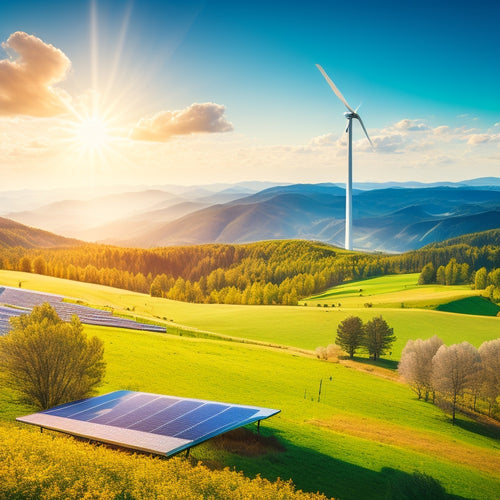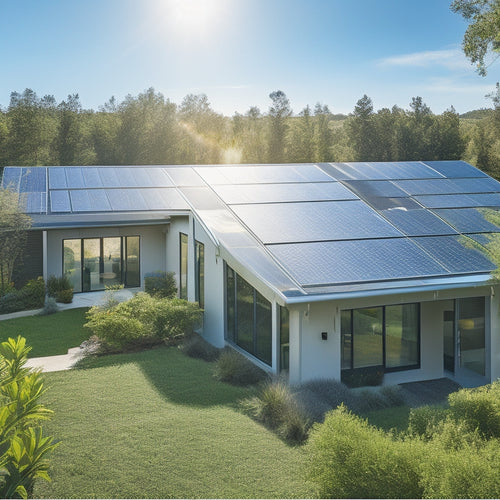
Solar Panels and Batteries for Home
Share
You're taking a significant step towards reducing your carbon footprint and gaining energy independence by considering solar panels and batteries for your home. By installing a solar panel system, you'll not only minimize your reliance on fossil fuels but also enjoy substantial savings on your utility bills. To optimize your energy production, it's important to assess your daily energy requirements and implement energy-efficient appliances. Maximum Power Point Tracking (MPPT) systems can further enhance your solar panel efficiency, while energy storage solutions provide backup power during outages. Now, identify the ideal system configuration to reveal your path to energy independence and examine the technical details that will make it happen.
The Essentials
- Transition to renewable energy with solar panels and batteries for a sustainable and environmentally friendly home.
- Capture solar energy and store it in batteries to reduce dependence on the grid and fossil fuels.
- Solar panels and batteries can provide significant savings on utility bills and increase home value and appeal.
- Energy storage solutions ensure backup power during outages, offering peace of mind and energy independence.
- Implementing solar panels and batteries requires understanding energy usage patterns and optimizing system design for maximum efficiency.
Reduce Carbon Footprint Easily
You can greatly reduce your carbon footprint by shifting to a renewable energy source, like solar power, and storing excess energy in batteries for later use.
By incorporating a reliable Solar Energy Storage solution, you'll be able to capture and store energy efficiently, ensuring a continuous power supply.
With a well-designed solar panel and battery system, you can minimize your reliance on the grid and enjoy considerable savings on your utility bills.
Go Green at Home
Most households can greatly reduce their carbon footprint by adopting simple, eco-friendly habits and incorporating renewable energy sources into their daily lives. By going green at home, you'll not only contribute to a more sustainable living environment, but you'll also increase your energy independence.
Start by implementing eco-friendly practices, such as reducing energy consumption, using energy-efficient appliances, and recycling. Then, consider investing in green technology like solar panels and energy storage systems, which can notably lower monthly electricity bills by utilizing free, renewable energy from the sun rooftop solar energy. These renewable resources will help you tap into the power of the sun, reducing your reliance on fossil fuels and lowering your carbon emissions.
Additionally, installing rooftop solar panels can increase your home's value and appeal, making it a more attractive selling point should you decide to move.
As you shift to a more sustainable lifestyle, you'll enjoy several environmental benefits. You'll reduce your energy consumption, decrease air pollution, and contribute to climate action.
Plus, with solar incentives, you may be eligible for rebates and tax credits. By going green, you'll not only be doing your part for the planet, but you'll also be increasing your home's efficiency and value.
Lower Energy Bills
Lower Energy Bills
Utilizing renewable energy from the sun can greatly reduce your energy bills, making it an attractive option for homeowners looking to lower their carbon footprint. By capturing the power of solar energy, you can considerably decrease your reliance on traditional fossil fuels, resulting in substantial energy savings.
This, in turn, translates to lower energy bills, allowing you to allocate your hard-earned money towards more important aspects of your life. With the ability to break free from reliance on the grid Renewable Energy Solutions, you can enjoy greater control over your energy needs and reap considerable cost savings.
By investing in solar power and battery storage systems, you can also provide backup power during outages and emergencies, offering peace of mind and safeguarding against lost productivity and spoiled food.
With solar panels, you can generate electricity during the day and store excess energy in batteries for later use. This setup guarantees that you're optimizing your energy consumption, reducing your overall energy expenditure.
The cost efficiency of solar energy is undeniable, and the long-term benefits far outweigh the initial investment. By switching to solar power, you'll not only reduce your carbon footprint but also enjoy considerable energy savings, giving you the freedom to live more sustainably and independently.
Low Electricity Bills Guaranteed
You'll be thrilled to know that with solar panels and batteries, you can greatly cut energy costs and even zero out your electricity bills.
By capturing the power of the sun and storing excess energy for later use, you'll reduce your reliance on the grid and lower your energy expenses.
With a residential solar energy system, you can enjoy the benefits of renewable energy and reduce your carbon footprint.
This means you'll enjoy a substantial decrease in your electricity bills, potentially even eliminating them altogether.
Cut Energy Costs
Every kilowatt-hour of electricity you generate with your solar panel system is a kilowatt-hour you don't have to purchase from the grid, translating directly to savings on your utility bills. By cutting your energy costs, you're taking control of your budget planning and enjoying real energy savings.
| Monthly Savings | Annual Savings | 10-Year Savings |
|---|---|---|
| $100 | $1,200 | $12,000 |
| $200 | $2,400 | $24,000 |
| $300 | $3,600 | $36,000 |
With solar panels, you're not only reducing your reliance on the grid but also shielding yourself from rising electricity rates. By producing your own clean energy, you're free from the volatility of the energy market. This means you can better plan your budget, allocate your resources more efficiently, and enjoy the peace of mind that comes with energy independence. By cutting energy costs, you're taking a significant step towards financial freedom.
Zero Out Bills
Zero Out Bills (Low Electricity Bills Guaranteed)
Typically, homeowners who invest in solar panels and batteries for their homes can expect to considerably reduce their electricity bills. However, with a well-designed system, you can take it a step further and zero out your bills altogether. By generating enough clean energy to power your home and storing excess energy in your battery for later use, you can break free from reliance on the grid and enjoy true energy independence.
With a solar panel and battery system, you can rest assured that you're producing sustainable energy and reducing your carbon footprint. This means you'll not only save money on your electricity bills but also contribute to a cleaner, healthier environment.
Imagine the freedom of not having to worry about rising energy costs or unexpected rate hikes. You'll have the power to control your energy usage and costs, enjoying the peace of mind that comes with sustainable living.
Maximum Power Point Tracking
You need a Maximum Power Point Tracking (MPPT) system to guarantee efficient energy harvesting from your solar panels.
This system's primary function is to track the ideal voltage at which your panels produce the maximum power, allowing you to utilize the most energy possible.
With a reliable home energy storage system in place, you can store excess energy generated during the day for later use.
Efficient Energy Harvesting
Within a solar panel system, efficient energy harvesting relies on Maximum Power Point Tracking (MPPT), an important feature that optimizes energy production by identifying the maximum power point of your solar panels. This feature guarantees you get the most out of your solar panels, even when environmental conditions change.
MPPT is vital for energy efficiency, as it allows your system to adapt to varying temperatures, shading, and other factors that affect energy production.
As you investigate sustainable technology for your home, MPPT becomes a significant component. By maximizing energy production, you reduce your reliance on the grid and lower your energy bills. This means you'll enjoy greater freedom from utility companies and a reduced carbon footprint.
With MPPT, you can be confident that your solar panel system is operating at peak performance, utilizing every available watt to power your home. By prioritizing energy efficiency, you're not only saving money but also contributing to a cleaner, more sustainable future.
Optimal Voltage Tracking
You've invested in a solar panel system to harvest energy independence, and now it's time to enhance its performance. Maximum power point tracking (MPPT) algorithms rely on ideal voltage tracking to pinpoint the precise voltage at which a solar panel operates most efficiently. This is essential, as even slight deviations from the ideal voltage can greatly reduce energy output.
As you know, solar panels don't always operate at their maximum potential due to varying environmental conditions, such as temperature and irradiance. To address this, MPPT algorithms continuously monitor the panel's voltage and current output. By doing so, they can adjust the operating voltage to guarantee maximum power output, even in less-than-ideal conditions.
Achieving voltage stability is vital to tracking efficiency. When the system operates at the ideal voltage, you can expect maximum energy harvest. This, in turn, translates to increased energy independence and reduced reliance on the grid.
Assess Your Energy Requirements
You need to understand your energy usage patterns to determine the right size of your solar panel system and battery bank.
Start by calculating your daily power consumption in watt-hours (Wh) to get an accurate estimate of your energy requirements.
For instance, considering your energy storage needs, you may want to investigate residential solar energy storage systems to optimize your energy usage.
Energy Usage Patterns
As you consider shifting to solar power, understanding your energy usage patterns is essential to determining the right system size and configuration for your home. Your energy usage patterns are unique, shaped by your lifestyle, habits, and appliance efficiency.
To accurately assess your energy requirements, you need to identify your consumption trends, peak usage periods, and seasonal variations. Energy monitoring systems can help you track your energy usage, providing significant observations for behavioral analysis.
By studying your usage patterns, you can identify areas for improvement, optimize your energy consumption, and select the most suitable solar panel and battery configuration for your needs. Usage forecasting will also enable you to anticipate and prepare for changes in your energy requirements over time.
Daily Power Consumption
The daily power consumption of your home is a critical factor in determining the ideal solar panel and battery configuration. To assess your energy requirements, you need to calculate your daily power consumption in watt-hours (Wh).
This involves identifying the total power consumption of all your appliances, lighting, and HVAC systems. Make a list of all your devices, their power ratings, and the number of hours you use them daily.
Next, calculate the total daily energy consumption by multiplying the power rating of each device by the number of hours used. Add up the energy consumption of all devices to get your total daily power consumption.
This information will help you determine the size of the solar panel system and battery bank you need to meet your energy requirements. By understanding your daily power consumption, you can optimize your energy efficiency and power management.
This guarantees that you generate enough energy to power your home and store excess energy in your battery for later use, giving you the freedom to live off the grid.
Higher Energy Conversion Rate
You'll want to maximize your solar panel system's energy conversion rate to guarantee efficient energy harvesting.
A higher conversion rate translates to more usable electricity from the same amount of sunlight, making the most of your available roof space.
Efficient Energy Harvesting
By integrating high-efficiency solar panels into your home's energy system, you can greatly enhance your energy harvesting capabilities, resulting in a higher energy conversion rate. This is vital for achieving energy independence, as it allows you to generate more power from the same amount of sunlight.
To optimize energy harvesting, it's important to take into account panel orientation, installation best practices, and maintenance tips. Proper installation guarantees that your solar panels are angled and positioned to maximize energy absorption, while regular maintenance helps prevent energy losses due to dirt, debris, or malfunctioning components.
When paired with energy storage solutions, such as batteries, your renewable technology can provide a reliable source of power even during grid outages or periods of low sunlight. Effective grid integration guarantees a seamless shift between solar power and traditional energy sources.
Frequently Asked Questions
Can I Install Solar Panels on a Shaded Roof?
You can install solar panels on a shaded roof, but you'll need to evaluate the shaded roof's impact on solar efficiency, as it'll reduce energy output; assess the shade's duration and intensity to determine the best panel placement and system design.
How Long Do Home Solar Batteries Typically Last?
As you'll soon find out, a well-maintained battery's lifespan can exceed 10 years, with some lasting up to 15; follow maintenance tips like monitoring temperature, updating software, and performing regular checks to guarantee your battery's longevity.
Are Solar Panels Resistant to Extreme Weather Conditions?
You'll be relieved to know that solar panels are built to withstand extreme weather conditions, boasting impressive durability and resilience in the face of heavy rain, hail, and even hurricane-force winds, ensuring your freedom from grid dependence remains uninterrupted.
Can I Use Solar Power During a Grid Outage?
As you break free from the grid's shackles, you'll find solace in solar energy storage, releasing grid independence; during outages, your stored power shines like a guide, illuminating your path to self-sufficiency, allowing you to utilize the sun's energy when you need it most.
Are Solar Panels Compatible With Existing Electrical Systems?
You'll need to verify your existing electrical system can support a grid connection, and may require electrical upgrades to accommodate the new power source, assuring a seamless integration and maximizing your energy independence.
Final Thoughts
By utilizing the power of solar panels and batteries for your home, you're not just reducing your carbon footprint - you're virtually eliminating it! Your electricity bills will plummet to nearly zero, and with maximum power point tracking, every last drop of energy is squeezed out. Assess your energy requirements and get ready to bask in the glow of a higher energy conversion rate. Get ready to save a small fortune and join the renewable energy revolution!
Related Posts
-

Solar Phone Chargers for Camping Essentials
Solar phone chargers are must-haves for your camping essentials, allowing you to stay connected while enjoying nature...
-

Renewable Energy Solutions to Reduce Your Carbon Footprint
To reduce your carbon footprint, adopting renewable energy solutions is key. Using solar panels or wind turbines can ...
-

Installing Metal Solar Roofs for Maximum Energy Efficiency
Installing metal solar roofs can drastically enhance your home's energy efficiency and durability. These roofs withst...


